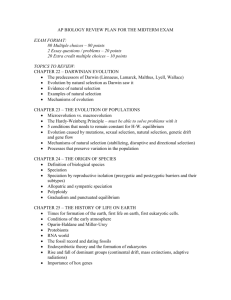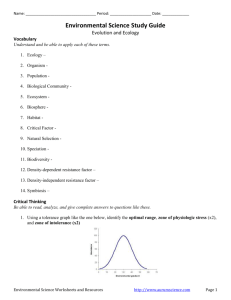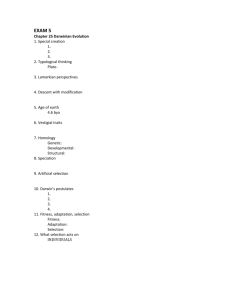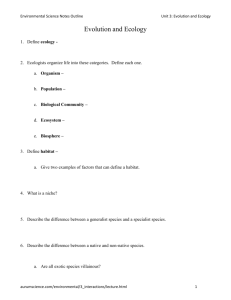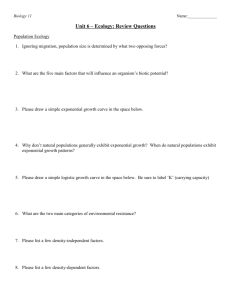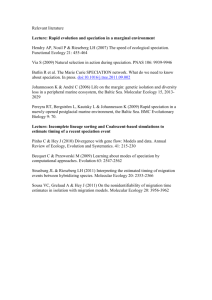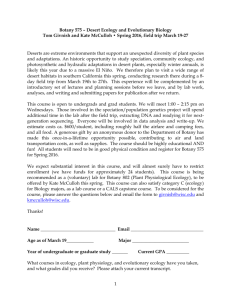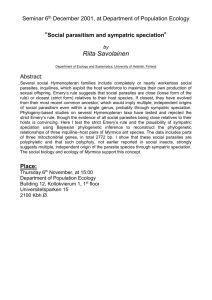AP BIOLOGY REVIEW PLAN FOR THE MIDTERM EXAM
advertisement
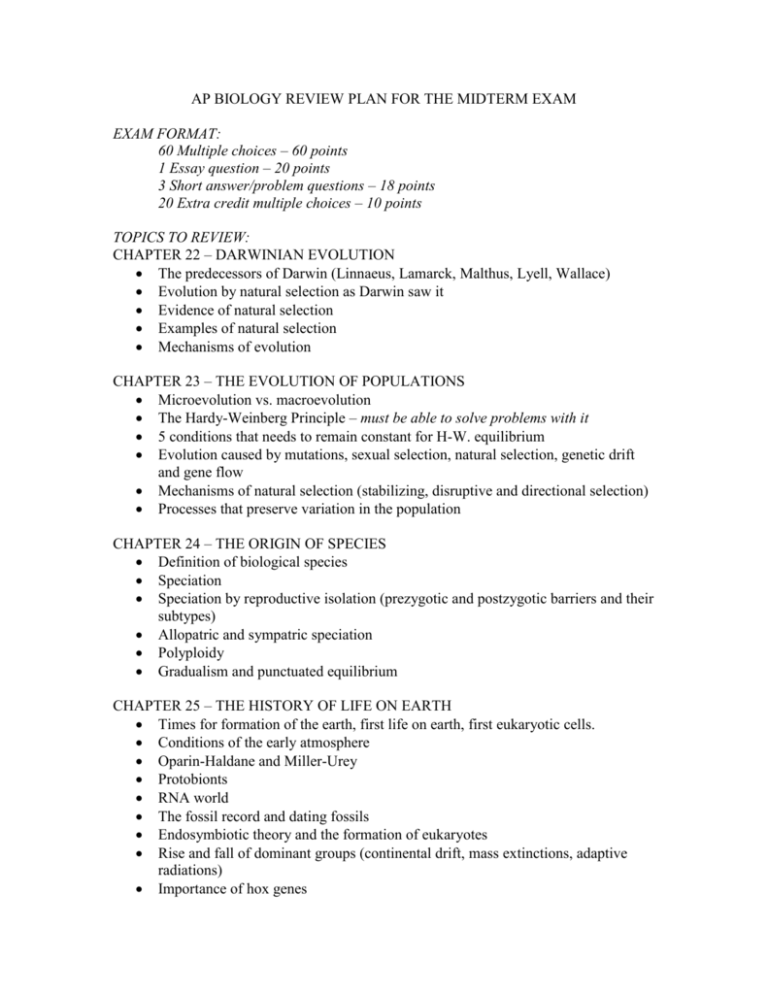
AP BIOLOGY REVIEW PLAN FOR THE MIDTERM EXAM EXAM FORMAT: 60 Multiple choices – 60 points 1 Essay question – 20 points 3 Short answer/problem questions – 18 points 20 Extra credit multiple choices – 10 points TOPICS TO REVIEW: CHAPTER 22 – DARWINIAN EVOLUTION The predecessors of Darwin (Linnaeus, Lamarck, Malthus, Lyell, Wallace) Evolution by natural selection as Darwin saw it Evidence of natural selection Examples of natural selection Mechanisms of evolution CHAPTER 23 – THE EVOLUTION OF POPULATIONS Microevolution vs. macroevolution The Hardy-Weinberg Principle – must be able to solve problems with it 5 conditions that needs to remain constant for H-W. equilibrium Evolution caused by mutations, sexual selection, natural selection, genetic drift and gene flow Mechanisms of natural selection (stabilizing, disruptive and directional selection) Processes that preserve variation in the population CHAPTER 24 – THE ORIGIN OF SPECIES Definition of biological species Speciation Speciation by reproductive isolation (prezygotic and postzygotic barriers and their subtypes) Allopatric and sympatric speciation Polyploidy Gradualism and punctuated equilibrium CHAPTER 25 – THE HISTORY OF LIFE ON EARTH Times for formation of the earth, first life on earth, first eukaryotic cells. Conditions of the early atmosphere Oparin-Haldane and Miller-Urey Protobionts RNA world The fossil record and dating fossils Endosymbiotic theory and the formation of eukaryotes Rise and fall of dominant groups (continental drift, mass extinctions, adaptive radiations) Importance of hox genes CHAPTER 26 – PHYLOGENY AND THE TREE OF LIFE Phylogenetic trees Cladograms Evidence of building phylogenetic trees o Homologous structures adaptive radiation o Analogous structures convergent evolution o Molecular clocks o Comparative molecular biology o Fossils Domains of life and their characteristics Kingdoms of life and their characteristics CHAPTER 50 – INTRODUCTION TO ECOLOGY levels of organization in ecology (population, community, ecosystem, biosphere) Abiotic factors Aquatic biomes Terrestrial biomes CHAPTER 51 – ANIMAL BEHAVIOR Types of behavior Fixed action patterns Kinesis and taxis Circadian and yearly rhythms in animal behavior and internal clocks (migration, sleep patterns, hibernation) Compass mechanisms The effects of the environment on animal behavior Ways for animals to communicate CHAPTER 52 – POPULATION ECOLOGY Ways to grow a population Population structure is described by density, dispersion and demography Exponential and logistic growth models K- and r-selection Density dependent and density independent population regulation CHAPTER 53 – COMMUNITY ECOLOGY Community interactions and adaptations o Intraspecific o Interspecific interactions (competition, predation, herbivory, disease and symbiosis – parasitism, mutualism, commensalisms) Niche (fundamental and realized) The competitive exclusion principle Coevolution Species diversity (species richness + relative abundance) Food webs and food chains Dominant species Keystone species Foundation species Ecological succession (primary and secondary) CHAPTER 54 – ECOSYSTEMS AND GLOBAL ENVIRONMENTAL ISSUES Energy flows through the ecosystem while matter is recycled Trophic levels and the energy flow Gross and net primary production Limiting factors of primary production in aquatic ecosystems Eutrophication Limiting factors of primary production in terrestrial ecosystems Evapotranspiration Secondary production Trophic efficiency (pyramids of numbers, production and biomass) Biogeochemical cycles (include the water cycle, carbon cycle, phosphorous cycle and the nitrogen cycle) Human disruption to the nutrient cycles (cultural eutrophication, acid precipitation, biological magnification, greenhouse effect, global warming, ozone depletion, loss of biodiversity) CHAPTER 2 – THE CHEMICAL CONTEXT OF LIFE Matter, element, compound everything on atomic structure, molecules, chemical bonds Isotopes, using radioactive isotopes polarity writing and balancing chemical equations CHAPTER 3 – WATER AND THE FITNESS OF THE ENVIRONMENT Chemical structure and bonding of water – relate these to the physical properties of water and to its biological function Characteristics of water and their function in living organisms acids, bases and buffers, pH Acid precipitation CHAPTER 4 – CARBON AND THE MOLECULAR DIVERSITY OF LIFE Characteristics of carbon Isomers (structural, geometric, optical) CHAPTER 5 – THE STRUCTURE AND FUNCTION OF MACROMOLECULES Polymers, monomers, macromolecules Condensation and dehydration synthesis The structure and function of carbohydrates The structure and function of proteins (including the four levels) The structure and function of lipids The structure and function of nucleic acids CHAPTER 8 – AN INTRODUCTION TO METABOLISM Metabolic pathways and enzymes Forms of energy The first and second laws of thermodynamics Definition of free energy ATP Enzyme structure and function Environmental conditions that influence enzyme function (temperature, pH, coenzymes Enzyme regulation (inhibitors, allosteric inhibitors and activators, cooperativity, feedback inhibition) CHAPTER 40 – PRINCIPLES OF ANIMAL FORM AND FUNCTION Levels of organization Animal tissues (epithelial, connective, muscular and nervous) (their structure and function) Animal organ systems (just list them) Homeostasis Positive and negative feedback mechanisms Thermoregulation in animals (ectotherms and endotherms) CHAPTER 41 – ANIMAL NUTRITION Animal feeding types Homeostatic process of glucose regulation Essential nutrients The main stages of food processing (ingestion, digestion, absorption, elimination) Digestion in sponges, cnidaria, round worms, earthworms, insects, and birds) Parts of the human digestive system, their structure and function Digestive enzymes, their place of production and their specific actions Adaptations to various diets CHAPTER 6 – EUKARYOTIC CELL STRUCTURE Cell size and surface to volume ratio The nucleus Ribosomes The endomembrane system (Endoplasmic reticulum, Golgi apparatus, Lysosomes and peroxisomes, vesicles and vacuoles) Mitochondria and chloroplasts Peroxisomes Extracellular matrix CHAPTER 27 AND 18.3 – PROKARYOTES Prokaryotic cell structure and function Gram staining Metabolic adaptations Prokaryotes role in the nitrogen cycle Prokaryotic genetics – chromosome structure, reproduction, recombination Types of recombination (transduction, transformation and conjugation) and transposons CHAPTER 7: The structure of the cell membrane Active transport (Diffusion, osmosis and facilitated diffusion) The cell’s behavior in hypotonic, hypertonic and isotonic solutions Active transport (sodium-potassium pump and other ion pumps, cotransport) Bulk transport (endocytosis and its types, exocytosis, receptor-mediated endocytosis) CHAPTER 44 – OSMOREGULATION AND EXCRETION Osmoregulation types (osmoconformers and osmoregulators) Types of osmoregulators in various environments Forms of nitrogenous wastes, their benefits and disadvantages Key functions of the excretory system (filtration, reabsorption, secretion, excretion) Survey of animal excretory systems (protonephridia, metanephridia, Malphigian tubules, kidneys) Anatomy of the mammalian excretory system Kidney anatomy The anatomy and physiology of the nephron From blood to filtrate Regulation of kidney function (ADH only) CALCULATIONS: Hardy-Weinberg principle Mean, median and mode of a set of data Standard deviation Graphing skills Surface area and volume relationship
